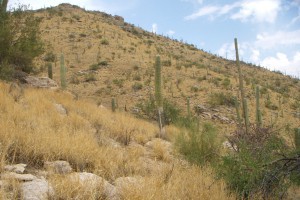- Slug: Buffelgrass Spread,770
- File photo available below
By BECKY BRISLEY
Cronkite News
PHOENIX – Invasive buffelgrass has colonized landscapes across southern Arizona over the decades, increasing wildfire intensity and threatening native vegetation.
Now officials point with worry at stands of buffelgrass taking root in and near the Valley.
Chandler Mundy, forest rangeland program leader at Tonto National Forest, said that buffelgrass now strewn across the Sonoran Desert and is beginning to spread in Tonto.
“We definitely consider it a major threat,” Mundy said. “It could really upset the ecosystems that are out here.”
And the grass has been taking over terrain in more developed areas as well.
“It’s definitely something we’ve been seeing in the Phoenix area,” said Sandy Bahr, director of the Sierra Club’s Grand Canyon Chapter. “This last year, after the rains we had, I felt like everywhere I looked in town I saw bushes of buffelgrass – in vacant lots, along the edge of parking areas.”
Claudia Bloom founded Phoenix Weedwackers in 2006 to combat scenes like this. She said the problem is getting worse in the mountain preserves because not much action has been taken in some areas, like Deem Hills north of Phoenix.
“While it isn’t as prevalent as in Tucson, given time and no action there is no reason it wouldn’t become the huge problem it is in the Tucson area,” Bloom said.
Neal Kittelson, invasive species project manager for the Southern Arizona Buffelgrass Coordination Center, said that buffelgrass essentially is converting a desert that’s evolved to resist fire into grassland.
“Historically the Sonoran Desert is very fire-resilient; there is bare ground separating most native plants,” he said. “If a fire starts because of a lightning strike, for example, the fire will burn itself out because there are no fuels to allow it to travel horizontally across the landscape. Buffelgrass fills in that bare ground which allows fire to move. “
Kittelson said buffelgrass poses a great threat to human safety in urban areas as well.
“It often grows in unmanaged,” he said. “The risk is that buffelgrass fires burns so hot and fast that a brushfire could easily move fast enough to cause structures to burn prior to responders to getting to the scene.”
Though buffelgrass hasn’t spread elsewhere as rapidly as it has in southern Arizona, it has still made a mark on Tonto as well.
“So right now we are seeing it moving into the uplands in some places,” Mundy said. “But primarily we see it along the roadsides, mainly the highways.”
Mundy said precautions are taken to keep the grass at bay along the roadsides, from chemically treating and spraying to old-fashioned pulling, often done by volunteer groups. But mowing is the tactic used most often. The grass resides along the sides of roads like U.S. 60 and U.S. 87, Cave Creek Road and others.
Buffelgrass is native to areas of Africa, Indonesia, northern India, Madagascar and Saudi Arabia, according to the Southern Arizona Buffelgrass Coordination Center. It was brought to the United States in the 1930s and 1940s for livestock forage and erosion control and soil stabilization. In southern Arizona in particular, buffelgrass wasn’t a threat until the 1980s, when it began to expand rapidly.
“We didn’t really understand what the problems were with it,” Mundy said. “The Sonoran Desert isn’t supposed to be a grassland. It should have a long fire interval, meaning it doesn’t burn very often at all.”
Mundy said that the saguaro cactuses cannot withstand fire, and that if they burn, they die and take a long time to grow back. Buffelgrass fuels unnaturally hot and large fires.
And though Mundy said fire is the biggest problem that buffelgrass creates, it also battles other plants in the ecosystem for space and the state’s most rare and precious resource.
“Buffelgrass quickly takes advantage of what little water there is,” he said. “So that also affects the native plants.”
Buffelgrass hasn’t spread to an extreme degree in Tonto National Forest yet , and Mundy said he and his colleagues aren’t quite sure why.
“Some people have said that maybe something will happen and it will just take off,” he said. “We could just be on the verge of something, or it could just mean we have slightly different conditions that don’t favor it.”
Bahr said that buffelgrass isn’t the type of problem that goes away if ignored, adding that it needs to be adequately addressed in order to preserve the unique desert ecosystem.
“There doesn’t seem to be an initiative until there is a crisis,” Bahr said. “But it’s almost always easier and cheaper to deal with things early on. We want to protect that diversity and protect what makes this place special.”
^___=

Buffelgrass blankets an area of the Santa Catalina Mountains near Tucson. (Photo by Aaryn Olsson, University of Arizona)